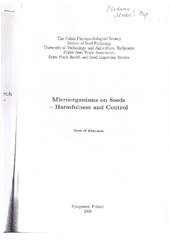Приказ основних података о документу
Soybean seed-borne fungal diseases in Vojvodina province
| dc.creator | Medić-Pap, Slađana | |
| dc.creator | Milošević, Mirjana | |
| dc.creator | Jasnić, Stevan | |
| dc.date.accessioned | 2022-05-05T08:27:29Z | |
| dc.date.available | 2022-05-05T08:27:29Z | |
| dc.date.issued | 2006 | |
| dc.identifier.uri | http://fiver.ifvcns.rs/handle/123456789/2606 | |
| dc.description.abstract | Numerous phytopathogenic microorganisms are associated with soybean seeds. Seed serves as a means of survival for pathogens and can provide primary inoculum for infected the new crop. The most significant and the most harmful are fungi. Soybean seed-borne diseases are present in Vojvodina province too. Occurrence of seed mycoflora is typically low, but intensive disease attacks may occur in some years. The aim of this paper was to determine the presence of phytopatogenic fungi on and in soyabean seed originating from 6 different seed companies in Vojvodina region. The following varieties most commonly used in production were tested: {2001-2002) 75 seed lots were tested. Fungi determination was done on the basis of morphological and growing characteristics. Presence of P. manshurica was determined by inspection of dry seeds. From soybean seeds were isolated fungi belonging to genera Diaporthe/ Phomopsis ( Phomopsis longicolla, D. p. var. caulivora and Phomopsis sojae) and Fusarium (F. graminearom, F. semitectum, F. equiseti, F. sporotrichoides, F. acuminatum and F. proliferatum). In most of the soybean seed samples fungi belonging to Al ternaria, Aspergilus and Penicillium genera were present. Besides above mentioned micoflora, a certain number of bacteria was also found on soybean seed, but they did not investigated further. Degree of soybean seed infection by parasitic mycoflora in both years of ob servation was relatively low. From 75 tested seed lots 11were free from parasitic fungi. Most of the samples had small percentage of seed infected by parasitic fungi (1-2%). Percentage of seed infection per sample with P. manshurica ranging from 1-53, Diaporthe/Phomopsis complex 1-113, and Fttsarium species 1-7%. Seed of Afrodita variety had the lowest percentage of infection, then comes Vojvodjanka, while Balkan and Ravnica varieties had the highest percentage of seed infection. Humidity, relatively high air temperature during maturation and harvesting time (August-Sepember) in 2001favoured intense appearance and distribution of para sites compared with the same extremely dry period in 2002 and significantly lower infection by parasitic fungi. | sr |
| dc.language.iso | en | sr |
| dc.publisher | Poznan : Polish Phytopathological Society | sr |
| dc.rights | openAccess | sr |
| dc.rights.uri | https://creativecommons.org/licenses/by/4.0/ | |
| dc.source | Book of Abstracts, 3rd International Seed Health Conference "Microorganisms on Seeds Harmfulness and Control", Bydgoszcz, Poland, | sr |
| dc.subject | soybean | sr |
| dc.subject | seeds | sr |
| dc.subject | fungi | sr |
| dc.subject | diseases | sr |
| dc.subject | Vojvodina | sr |
| dc.subject | Serbia | sr |
| dc.subject | mycoflora | sr |
| dc.title | Soybean seed-borne fungal diseases in Vojvodina province | sr |
| dc.type | conferenceObject | sr |
| dc.rights.license | BY | sr |
| dc.citation.epage | 32 | |
| dc.citation.spage | 32 | |
| dc.identifier.fulltext | http://fiver.ifvcns.rs/bitstream/id/7201/bitstream_7201.pdf | |
| dc.identifier.rcub | https://hdl.handle.net/21.15107/rcub_fiver_2606 | |
| dc.type.version | publishedVersion | sr |


